We independently evaluate all recommended products and services. Any products or services put forward appear in no particular order. If you click on links we provide, we may receive compensation.

Key Specs: Kubey Momentum
Founded in 2014 and located in Yangjiang (stop me if you’ve heard this before) in the Guangdong province of China, Kubey is located among many – if not all – of its peers, in the epicenter of cutlery in China. Their production facilities do everything from wire EDM cutting to hand finishing, and their line of knives runs from the $30 Tarzan flipper up to the wild Drake framelock with sculpted titanium handles and an S90V blade. The Momentum fits somewhere in the middle, our yellow translucent G10 test model with upgraded AUS-10 blade steel ringing up at a $70 MSRP. The AUS-10 version of the Momentum looks to be limited to Kubey’s website and Aliexpress currently, where you can buy it for $56 retail. The Momentum is designed by Sherif Manganas, an Industrial Designer located in Los Angeles. With roots in automotive design as well as success in drone racing, Manganas moved into knife design in 2019 and now has several production collaborations with both Kubey and Kizer, all with design roots tracing back to his earlier work. The Momentum is a unique folder with dual opening mechanisms, a super smooth action, and a pleasingly slim profile in the pocket for such a beefy folder. Let’s take a closer look.
The Blade
The Momentum is available in two versions; a basic model with D2 steel and our test example’s upgraded AUS-10 stainless steel. Advantages of AUS-10 over D2 are more about overall performance than ultimate edge retention; while it contains less carbon (1.1% vs 1.55%) and molybdenum than D2, it has higher concentrations of chromium (13-14.5% versus 11.5%) making it more corrosion resistant, and it also includes Nickel and Silicon for increased strength. AUS-10 is an upgraded version of AUS-8, and looking at the chemical composition makes it obvious: it’s identical to AUS-8 except for carbon content (.95-1.1% versus AUS-8’s 0.75-0.85%) which is the primary determinant of edge retention. So you can expect it to perform like AUS-8, but hold an edge slightly longer. Where does that put AUS-10? Somewhere mid-pack in terms of knives in this price range, with less edge retention than D2 but better corrosion resistance, but slightly better performance than 14c28n or 8Cr13MoV in most regards. It’s a fine steel for the price, but not revolutionary.
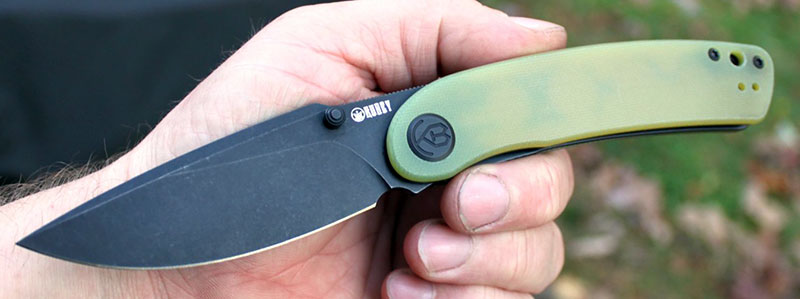
The blade itself is a modified drop point, with a 3.43” blade length and coming in at 1.14” wide at its tallest point. Blade stock is pretty thin for a circa 3.5” blade at 0.12” across the spine, and the Momentum sports a high flat grind with a radiused transition from the flats into the primary bevel. The blade shape is funky, sporting a false swedge along the spine that turns into a thumb ramp above the thumb stud, including a long row of jimping for grip. A sharpening choil is present, eliminating the “beard” at the terminating end of the edge, and the entire sharpened length is one long curve – this blade’s got plenty of belly for slicing. The tip is acute for piercing but its cross section is bolstered by that false swedge up top to give it some strength. The whole blade profile is quite useful, and the front flipper tab is of course hidden when the blade is in an open position. My test sample features a dark stonewashed finish on the blade, but the Momentum is also available with a bead blast finish as well.
Deployment & Lockup
Deployment is the most interesting feature of the Momentum, offering two different opening methods: dual thumb studs or a front flipper. A lot of the time, knives with two opening methods clearly have one that was designed to work and another that’s either just aesthetic flair or feels tacked on after the fact – like the O’Knife Splint Ti, which featured a great finger flipper, a difficult front flipper, and a basically useless oblong thumb hole. Not so on the Momentum, which works equally well from both the front flipper and the studs. The thumb studs have just enough clearance to the scales when closed to get the pad of your thumb in them without having to look, and a gentle push overcomes the detent and sends the blade open every time. The front flipper is equally successful, sticking out far enough past the end of the scales to give you plenty of space to place the side of your thumb. A solid push in a circular motion opens the blade up reliably.

The pivot on the Momentum uses caged ceramic ball bearings in an integrated cassette and deployment, after a short break-in period, is just insanely smooth. Despite the inherent tension of the detent ball on the locking liner, the Momentum is drop-shut smooth out of the box, able to close under the weight of its own blade.
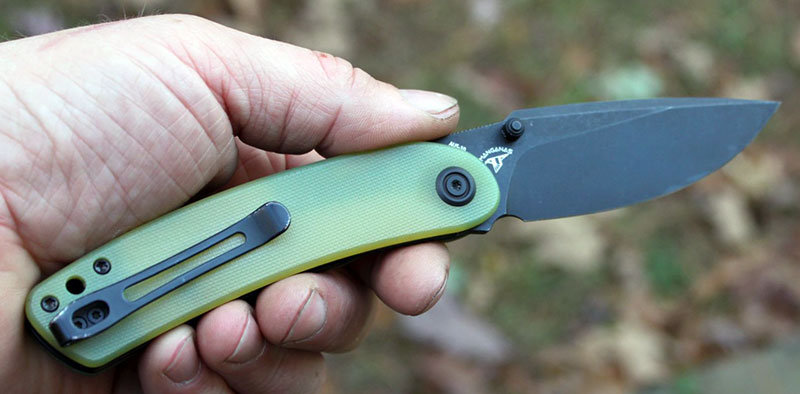
Lockup is via a steel liner lock, located with an external stop pin. Lock geometry appears to be perfect, with a firm flick settling the face of the locking liner exactly flush with the outer edge of the blade tang – ideal engagement with plenty of space for wear over time. There is zero blade play in any direction when open. Flawless, as far as liner locks go.
Features, Fit & Finish
This is a pretty snazzy knife for a $70 MSRP, I have to say. While there are many options for scale colors (black, camo, olive drab, translucent jade, and red), I’m fond of these translucent yellow G10 scales which allow you to see some of the structure of the liners through them depending on light – and the liners are black coated which gives them a greater contrast for visibility. The surface of the scales has a mild checkered texture, and the edges are chamfered all the way around for a smooth grip.
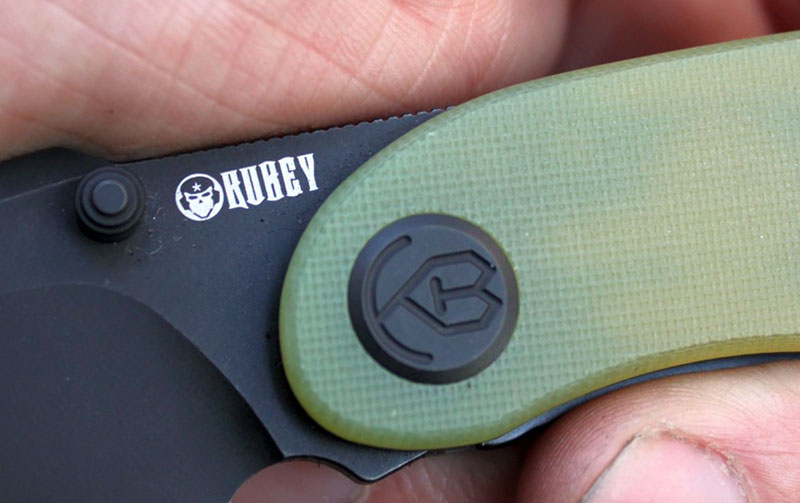
As is all the rage these days, the Momentum has a decorative oversized pivot on the show side with the Kubey logo – a stylized “KB” – which is black coated on knives with a black blade, or satin finish on models with the bead blasted blade. Construction of this knife is flow-through, with two hourglass-shaped standoffs supporting the liners at the rear, and all screws are either Torx T8 (pivot and body) or Torx T6 (clip screws). One seriously odd aspect is how the pivot is assembled – that decorative pivot pin acts as an anti-rotation mechanism for the pivot screw on the lock side, with a round nub on the underside of the decorative pivot matching up with a cutout in the G10 scales to both locate the position of the KB logo parallel with the centerline of the scales as well as preventing the barrel from turning when you’re tightening or loosening the pivot screw.
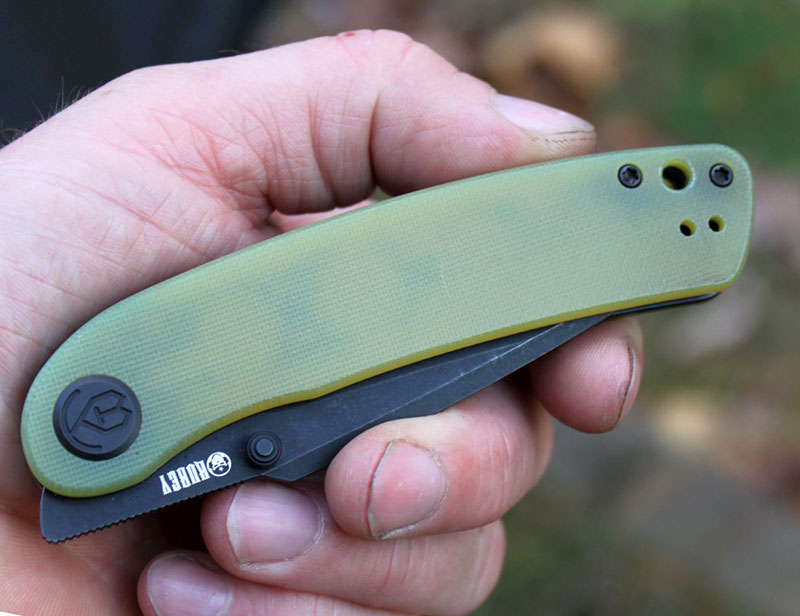
What’s really odd is that this is a backwards Chicago-style pivot, meaning the decorative pivot – which is normally a combination of the pivot barrel and a female threaded end – is actually just the short male screw, and the pivot screw – which is normally a short male screw that threads into the pivot barrel – is the female end and the pivot barrel. As we’ll discuss later, this makes assembly and disassembly complicated, and I have no idea why it’s designed this way.
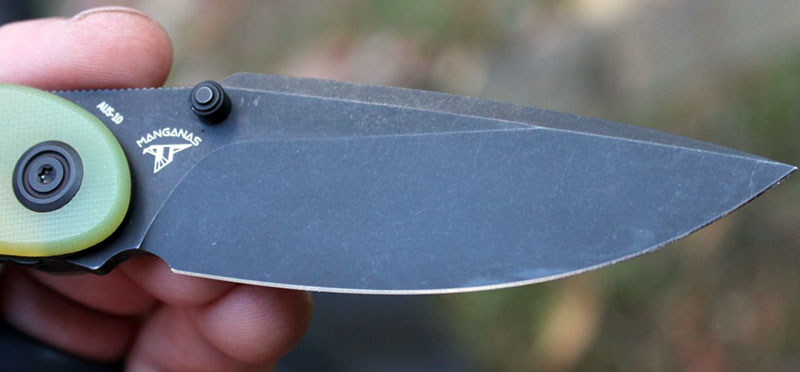
The pocket clip is a fairly normal bent steel deep carry setup, with two vertical screws under the fold-over that thread through the scales and into the steel liners. It’s configured for ambidextrous tip-up carry, and comes from the factory in the right-hand position. It’s also painted black to match the blade, pivot, liners and screws. There are a few logos on the blade, none particularly huge, including the show side pivot, the Kubey name and logo behind the thumb stud, and the designer logo and steel type behind the thumb stud on the lock side. As mentioned previously, there is jimping on both the spine in the thumb ramp area and on the locking liner to assist in releasing the lock, but nowhere else it’s not needed. A lanyard hole is positioned between the two standoffs at the rear of the handle. Finally, assuming you can operate a liner lock with your left hand, the knife is ambidextrous – dual thumb studs, a front flipper, and a two-sided clip mean it stores and opens equally well for southpaws.
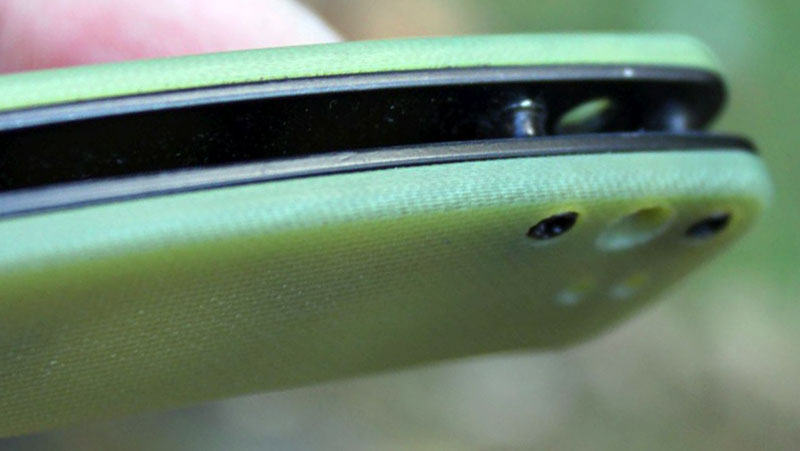
Build quality is mostly very good. Out of the box, the blade sits perfectly centered against the rear standoff in the closed position. Both liners sit flush with the scales, and there are no burrs or sharp edges left on the liners anywhere. The only thing I don’t love is the factory grind – it’s slightly asymmetrical, shallower on the lock side than the show side, and it has a slightly toothy finish like it could have used a pass on a finer grit belt before it got shoved in a box. It was still quite sharp out of the box, able to cut printer paper at an angle and shave arm hair easily, so this is mostly a complaint without a result. Other than that, this is a very well-made knife for the money.
Field Test
I posted a picture of the knife shortly after receiving it on Instagram, and the designer himself commented – “I hope you enjoy it! It was meant for work!” That’s apt, Sherif. The Momentum is absolutely meant for work, starting with the no-nonsense blade shape. Drop points are the be all/end all of useful blade profiles, and frankly any deviation from a drop point has always seemed like a styling affectation at the expense of usefulness. This is a great blade shape, with tons of belly for rolling cuts, a nice sharp tip for piercing stubborn materials, and a solid thumb ramp for grip. Grip on the Momentum is above reproach, offering plenty of real estate and no scallops or odd shapes that force your hand into a position. It’s got a gentle curve to the handle that orients the edge slightly downward, forcing the blade naturally into whatever you’re cutting. No hot spot from the low-profile deep carry clip either, the Momentum just feels like a well-designed tool in the hand. It also feels great in the pocket, thanks to a well-designed deep carry clip and a relatively narrow 0.51” handle width. It’s not notably lightweight at 4.48 ounces, but the weight was never an issue when I carried it.
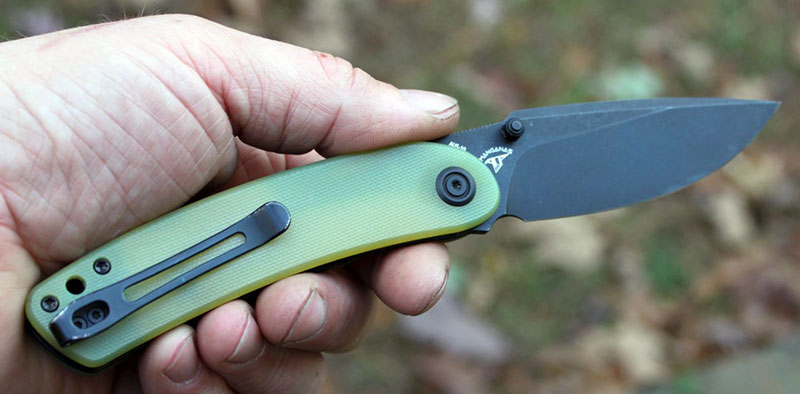
Maintenance is annoying, though. The backwards Chicago-style pivot makes disassembly and reassembly more difficult than it needs to be, made worse by the presence of red Loc-Tite on the pivot – and strangely, blue Loc-Tite on the body screws. Kubey – no high yield thread locker on screws, please! Once you take the pivot screw (and barrel) out, cleaning is normal, but reassembling requires you to pass the pivot screw through the lock side handle, then slide a bearing cassette on, followed by the blade, followed by another bearing cassette, then line everything up (including the stop pin in both liners!) Then, while holding the pivot collar down in place on the show side – that locating nub is rather shallow, and requires downward pressure to locate as opposed to the usual D-shaped pivot barrel – figure out how to thread the screw and barrel onto the pivot collar without cross threading it. It’s just much more difficult than how knives are normally assembled, and after scratching my head for a while I still haven’t figured out why they did it this way. Unless this was an assembly error and the red thread locker was supposed to go on the pivot collar to pivot barrel? It’s hard to tell since the barrel doesn’t come off the screw.
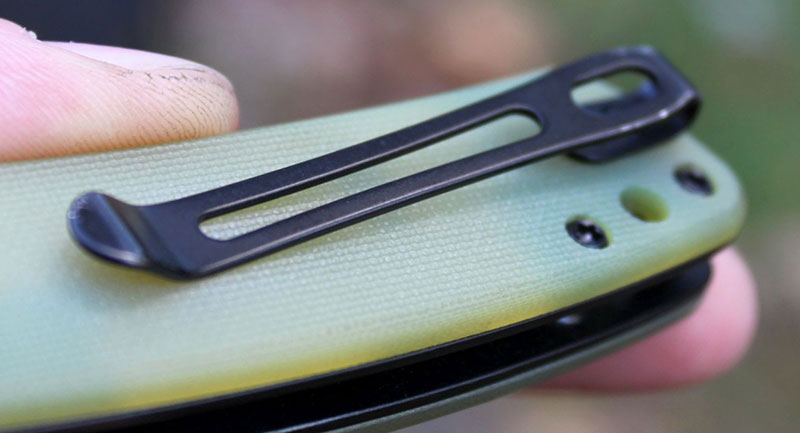
This is the first knife I’ve reviewed in AUS-10 steel, but a glance at a steel chart tells you what to expect. It holds an edge better than AUS-8, but not as well as standard D2 – after a few weeks of use at work, I noticed some small chips and rolls in the edge. It’s easy to sharpen, but I do think you’re probably better off saving a few bucks and getting the D2 version if you’re not as worried about corrosion resistance.
Alternatives
All these knives available at BladeHQ.
Shockingly, there aren’t really many direct competitors in this price range – if you go on to BladeHQ, search “front flipper” and then add the “Under $100” and “Blade size: 3-3.49” filters, there are precisely four. And three of them are out of stock. The Boker Plus Bonfire Micarta looks quite nice, the German company’s take on modern traditional patterns, with a 3.375” drop point blade in satin finish D2 steel, a nail nick and a front flipper, and ball bearing deployment. At $74.95 it’s right in the Momentum’s price range, although surely aimed at a different buyer with it’s green canvas Micarta scales and satin finished bolsters, looking for all the world like a GEC or something at first glance. It’s also lighter at 3.7 ounces, but doesn’t offer an ambidextrous pocket clip or thumb studs.
Slightly smaller and slimmer, both the Kizer Feist and the Real Steel G5 Metamorph offer bearings and front flippers at under $100, although plenty of fancier versions of the Feist go for more than that. The Vanguard line Feist offers G10 scales in several colors, and a CTS BD1N blade measuring 2.8” with a spear point pattern. I personally prefer the Momentum’s front flipper action, but the Feist is a modern classic. The G5 Metamorph is even weirder, super slim profile with alien looking lines, and offers aluminum handles and a 3.5” blade in Sandvik 14C28N for $60. It’s super light at 2.6 ounces, but there’s quite a lot less knife there despite the longer overall length (7.91 for the Momentum, 8.125” for the Metamorph.)

Dropping the front flipper qualification from the search (so folding knives under $100, 3-3.49” blade length, and thumb studs) brings back 919 options on BHQ, so… a bit broader of a market. One standout option that seems comparable is the Civivi Imperium. You can get it with wild contoured shredded CF handles, and Damascus blades, but the standard version – with Nitro-V steel and Jade green G10 handles – seems like a serious bargain at $50. It has a 3.47” drop point blade with a stonewash finish, flat G10 scales with an ambidextrous deep carry clip, and opens on a ceramic bearing pivot via dual thumb studs. It’s lighter than the Momentum at 3.15 ounces, but it also has a slimmer profile as well. Civivi build quality has always been stellar in my experience, so it’s hard to go wrong.

Wrap-Up
It must be said, for a knife from a company that was founded 8 years ago, designed by a person who started out in this industry 4 years ago, the Momentum absolutely rules. The rate at which the cutlery industry is evolving in Yangjiang brings to mind how quickly the South Korean auto industry got up to speed – this knife is better built and has more innovative features that actually make it work better than some companies that have been around 10 times as long are putting out.

I like the looks of the knife, the absolutely fantastic build quality, the addictive action via two different deployment methods that both work perfectly, and the no-nonsense blade shape. I really enjoyed carrying and using the Momentum for this review, and I think you will too.
- Excellent action, thumb studs and a front flipper that both work perfectly, flawless lockup, great build quality, good price.
- Backwards construction of pivot makes disassembly annoying, AUS-10 edge retention is mediocre, some rivals are lighter.
Kubey Momentum
Quality/Performance - 77%
Value for Money - 85%
81%
Save a few bucks, buy the D2 version of the Momentum, and put it to work. It’s a great knife.





